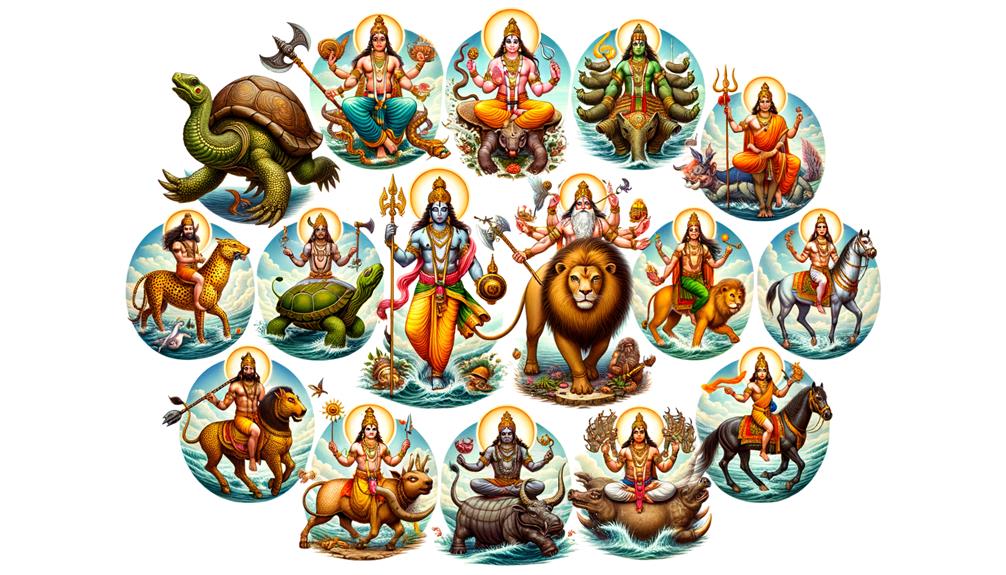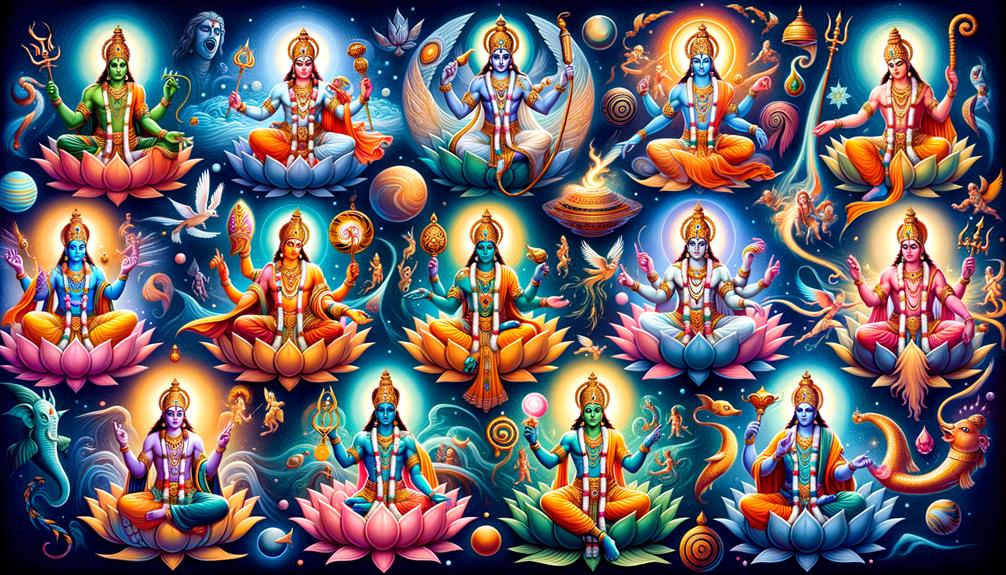Diving deep into the fascinating world of Vishnu's avatar incarnations can be compared to navigating a complex masterpiece, spun from the threads of mythology, spirituality, and philosophy. As we study each avatar, from the fish Matsya to the warrior prince Rama, it becomes obvious that they are more than just divine beings. Each avatar is a powerful lesson, wrapped in a celestial form. They symbolise the cycle of life, the constant battle between right and wrong, and the victory of virtue in the end. The avatars offer a fresh perspective on the world and have a powerful influence on the societal and religious norms of Hindu culture. But why does Vishnu decide to adopt these specific forms across different periods? And how do these incarnations impact a seeker looking for spiritual enlightenment? These thought-provoking queries are what we'll delve into next.
Understanding Vishnu's Avatar Concept

Let's delve into the intriguing world of Hindu mythology and discover the ten avatars of Vishnu. Each avatar, or incarnation, symbolizes a divine mission and gives us a unique insight into how the divine intervenes in the human world. The avatars include figures like Matsya and Kurma, each serving a unique purpose.
Other avatars like Parashurama, Rama, Krishna, and Buddha, each played a role in restoring balance and righteousness in their own times. They are seen as manifestations of the divine, offering spiritual guidance to their followers. The belief in these avatars is a key aspect of Hinduism, showcasing Vishnu's active role as the preserver.
Buddha, considered the ninth avatar in some texts, spread the teachings of Buddhism, advocating for non-violence and compassion. The tenth avatar, Kalki, who is yet to arrive, symbolizes the ultimate victory of good over evil and the start of a new cycle.
These ten avatars of Vishnu provide a profound understanding of the intricate and rich fabric of Hindu belief. They act as reminders of the ever-present divine influence subtly shaping the course of human history.
Detailed Insights Into Dashavatar
Let's discuss Dashavatar, the ten forms of Vishnu, and dig deeper into the unique stories and important lessons each one brings to the rich world of Hindu mythology. From the first avatar, Matsya, to the prophesied tenth, Kalki, each version of Vishnu tells a unique story filled with symbolism and moral guidance.
For instance, let's examine some key examples of Dashavatar:
- Vishnu's first avatar, Matsya, saved the world from a devastating flood, demonstrating the idea of divine rescue during universal crises.
- As Narasimha, Vishnu took the form of a half-man, half-lion to defeat the unbeatable demon king Hiranyakashipu, highlighting that evil, no matter how potent, will eventually meet its downfall.
- The Vamana avatar, appearing as a small Brahmin, humbled the powerful king Mahabali, reminding us of the dangers of unchecked ambition and ego.
- The yet-to-arrive Kalki avatar, poised on a white horse, is predicted to purify the world from its decay, emphasizing the cyclic nature of time and the enduring victory of good over evil.
These various forms of Vishnu enrich the moral and philosophical lessons found in Hindu mythology, resonating throughout time and across cultures.
Symbolism Behind Each Incarnation

Let's talk about the symbolic meanings behind each incarnation. They do more than just demonstrate good prevailing over evil. They also provide a wealth of lessons and spiritual advice. The Hindu texts, Vishnu Purana and Bhagavata Purana, tell us that Lord Vishnu took on various avatar incarnations to maintain righteousness (dharma) and fight against dark forces.
For example, the Matsya incarnation takes the form of a fish, symbolizing divine power that saves the world from a disastrous flood. The Kurma avatar, represented by a turtle, is a symbol of extracting cosmic knowledge from the milk ocean. The boar, Varaha, is a symbol of rescuing Mother Earth, reminding us of our responsibility towards the environment.
Then we have Narasimha, the half-man half-lion, who kills a demon king, symbolizing the destruction of ego and ignorance. Vamana, the dwarf, is a symbol of humility and the need to control our desires. The later incarnations, Parashurama, Rama, Krishna, and Buddha, each symbolize courage, love, wisdom, and compassion. Finally, the yet to come Kalki avatar is expected to be the greatest symbol of good winning over evil. Getting to know the symbolism behind each incarnation helps us understand Vishnu's divine roles and teachings better.
Vishnu's Avatars and Their Impacts

Let's chat about the avatars of Vishnu and the remarkable influence they've had on our universe and spiritual comprehension. Vishnu, the Hindu deity that maintains life, has avatars that play a crucial role in keeping the cosmic equilibrium and safeguarding dharma.
- For instance, Vishnu stepped into the role of Matsya, his first avatar, to protect humanity from a devastating flood. This showcases the importance of survival and resilience.
- Then came Narasimha, the fourth avatar, who overpowered a brutal demon king, demonstrating how divine forces step in during periods of dire injustice.
- As Parashurama, Vishnu's sixth incarnation, he ousted corrupt kings, underlining the importance of virtuous leadership.
- Krishna, Vishnu's eighth incarnation, shared the wisdom of the Bhagavad Gita amid the Mahabharata war. This served as a reminder of our dharma and life's fleeting nature.
The term avatar translates to 'descent', encapsulating these divine interventions by the Hindu deity to re-establish peace. Each avatar's influence goes beyond the realm of myth, echoing in our lives as teachings of righteousness, bravery, and dedication. Consequently, Vishnu's avatars aren't merely divine manifestations. They're enduring symbols that carry spiritual truths and shape our comprehension of the universe.
Debunking Vishnu Avatar Misconceptions
In Hindu mythology, there are often misunderstandings about Vishnu's avatars that can hinder our comprehension. It's essential we clear up these errors to fully grasp their unique roles and meanings. A common error is the belief that Lord Vishnu only has four incarnations. However, Hindu mythology tells us that Lord Vishnu took on ten forms, known as Dashavatara, to maintain cosmic balance.
People also frequently misunderstand the avatar Vamana. Despite being depicted as a dwarf, Vamana is not insignificant. His story is a powerful representation of humility and righteousness, showing Lord Vishnu's dedication to protecting Dharma.
Another error is thinking that the avatars are merely gods in different forms. They are instead divine manifestations with unique missions to restore balance and provide spiritual teachings.
Frequently Asked Questions
What Are the 10 Avatars of Vishnu in Order?
Let's talk about the ten avatars of Vishnu, shall we? They're listed in sequence, starting with Matsya, followed by Kurma, Varaha, Narasimha, Vamana, Parashurama, Rama, Krishna, Buddha, and finally, Kalki. Why do these avatars matter, you ask? Well, each one of them marks a moment when divine intervention was needed to help restore balance and uphold dharma in the world. Quite fascinating, isn't it?
How to Know Kalki Avatar?
The enigma surrounding Kalki, the ultimate incarnation of Vishnu, often leaves me engrossed. According to prophecy, he is yet to make his grand appearance. His mission? To eradicate wickedness, marking the end of the Kali Yuga, and initiate a fresh era of virtue, all while riding his majestic white steed.
What Will Happen if Kalki Avatar Comes?
Imagine what would transpire if the Kalki Avatar were to make an appearance. The prevailing belief is that he would bring forth an end to this current age steeped in malevolence, overcoming evil and laying the groundwork for a fresh epoch of virtuousness. In the simplest of terms, he would hit the restart button on the world, ushering in an era marked by tranquility and unity.
How Can I Call Lord Vishnu for Help?
If you're looking for ways to ask for Lord Vishnu's aid, you might want to try reciting certain mantras and prayers. It's a good idea to concentrate on the avatar of Lord Vishnu that best matches your needs, and create a heartfelt bond. What really matters is approaching this with an honest heart and true belief.
